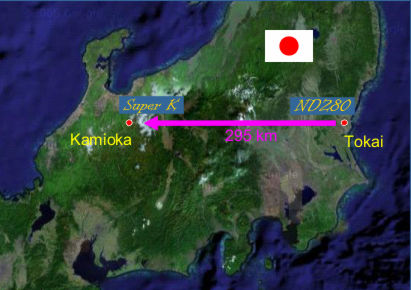
Welcome to the home page for the T2K experiment in Toronto. T2K is a neutrino oscillation experiment in Japan, designed and constructed from 2004-2010, and now accumulating physics data. It studies a beam of neutrinos, produced at J-PARC (near Tokai, 100 km northeast of Tokyo), and sees how the neutrinos have changed when they reach the Super-Kamiokande detector, 295 km away in the Kamioka mine.

Neutrinos are tiny fundamental particles in the Standard Model of Particles and Interactions. (A collection of general neutrino websites is given in the links section of this website.) Like quarks and electrons, they are basic building blocks of nature. They have no electric charge and very tiny masses, allowing them to travel very close to the speed of light. Since they only interact weakly, they can easily travel through large amounts of material (like the Earth). Though they are very difficult to detect, they are produced abundantly in nature. An average banana emits a million neutrinos per day, and every second hundreds of billions of neutrinos from the core of the Sun travel through your fingernails.
What are Neutrino Ocillations?Neutrinos come in three flavours: electron neutrinos, muon neutrinos and tau neutrinos. There is now compelling evidence (from neutrino experiments such as Super-Kamiokande, KamLAND, and SNO) that neutrinos that are produced in one flavour can change into another flavour. The most-favoured mechanism for this flavour change requires neutrinos to have non-zero masses that are different for the different neutrino flavours. The probability of measuring a neutrino in any particular flavour state varies with the energy of the neutrino and the distance that is has travelled. It also depends on three mixing angles and the three differences between the neutrino masses.
The primary goal of the T2K experiment is to study neutrino flavour changes as the neutrinos travel 295 km through the Earth from Tokai to Kamioka. The beam of neutrinos is primarily muon neutrinos when it is produced. Approximately 280 m from the start of the neutrino beamline, they pass through a near detector where the initial composition of the beam is measured. At Kamioka, the Super-Kamiokande detector is used to look for the disappearance of muon-flavour neutrinos and the appearance of electron-flavour neutrinos.
The electron neutrino appearance observation is particularly important since it yields a measurement of one of the three neutrino mixing angles (called theta13) that was not previously measured. This angle has now been measured by reactor experiments to be relatively large (the first indication of this was an exciting result from T2K in 2011 result from our early data-taking), which means that it will be possible to look for CP violation in neutrinos. CP violation is believed to be one of the necessary conditions (the so-called Sakharov Conditions) to explain the matter/anti-matter asymmetry in the Universe (i.e. why we are made of matter and not anti-matter when both should have been produced in equal amounts in the Big Bang). Thus CP violation in neutrinos might play a crucial role in explaining our existence. T2K and a new experiment called NOVA at Fermilab coming online in 2013 are in hot pursuit of the goal to measure CP violation.